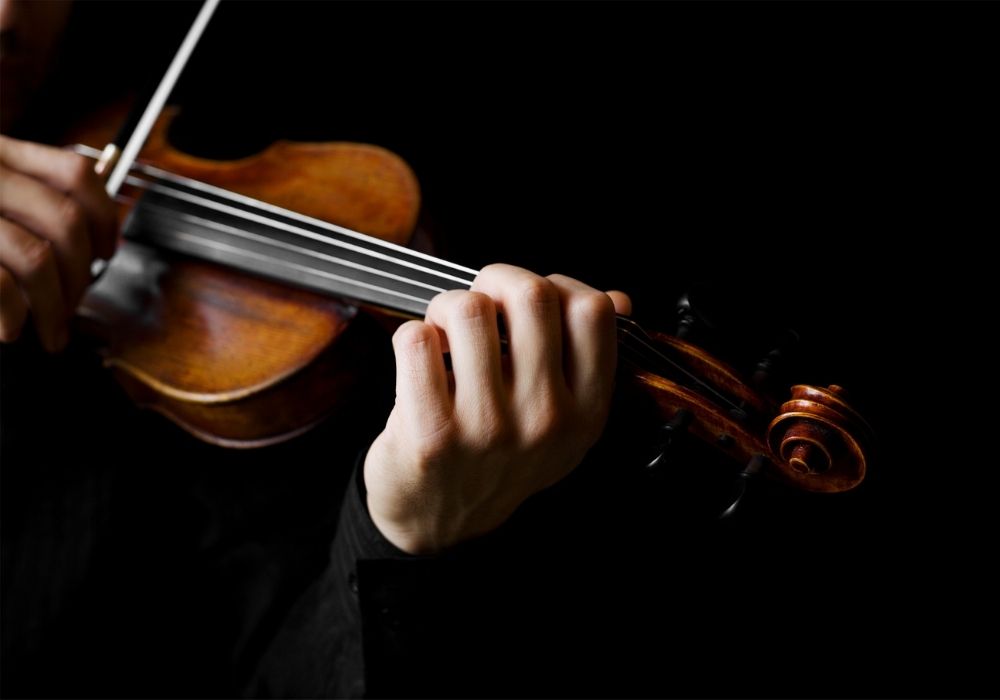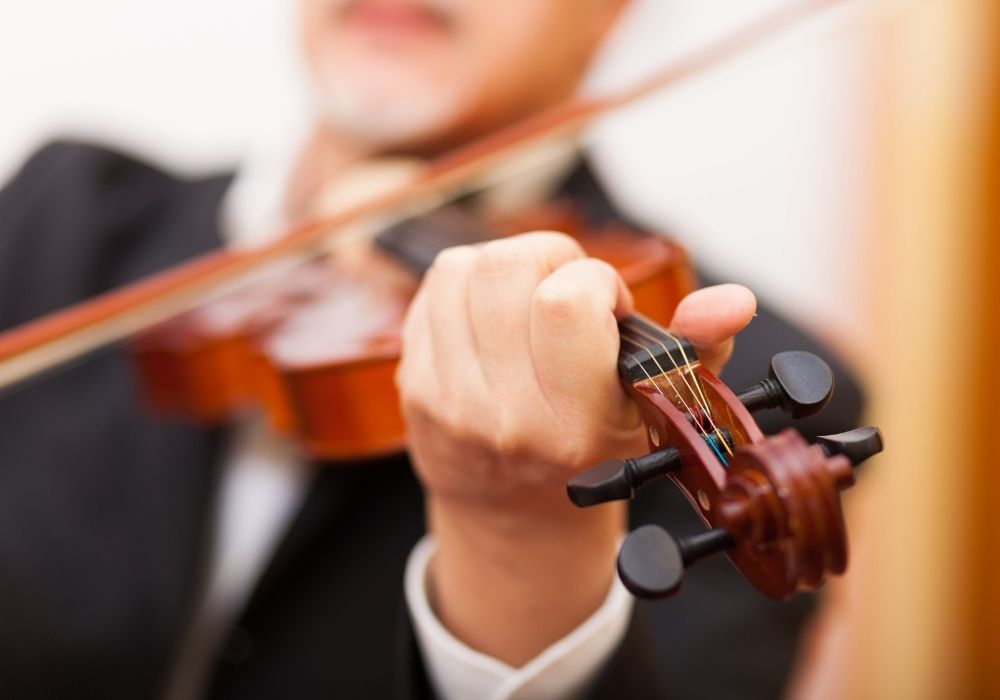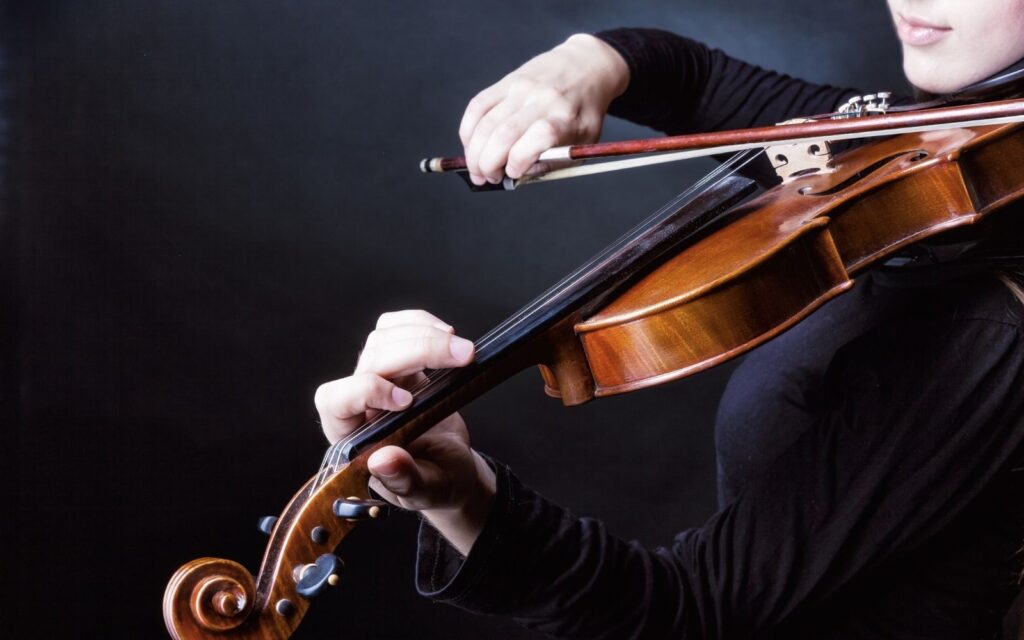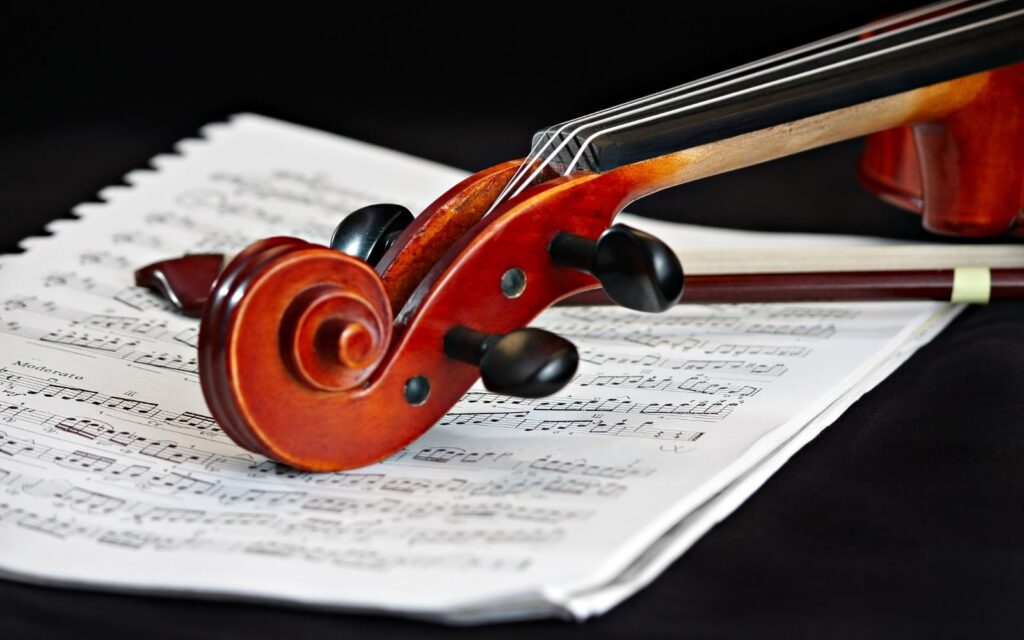Are you stuck in a musical rut and looking for new things to listen to? Or are you falling in love with the violin and looking for ways to learn more? If so, this is the guide for you! There are millions of pieces written for the violin, and the shear size of the genre can be overwhelming.
In this article, I’m going to share some of my favorite pieces, or those that are particularly significant to the history of the violin and classical music, to help you start or continue your listening journey.
As a professional violinist and teacher, I’ve been performing and listening to this music for almost my entire life. Since I’m primarily a classical musician, this article will highly reflect music from the classical repertoire, although there are many wonderful examples of violin music in other genres.
I encourage you to listen diversely, but since we don’t have unlimited space, I’ll focus specifically on classical music here.
Table of Contents
While the title suggests that these are the “best” pieces, this list is entirely subjective and based on my personal experience and knowledge of the repertoire. I urge you to use this guide as a jumping-off point for your listening, to inspire you in new directions. Let yourself go down some rabbit holes and follow your interests!
What Makes a Great Violin Piece?
Composers have written a truly enormous amount of music for the violin, and for good reason. It’s one of the most expressive and adaptable instruments in existence, and composers have used it to channel a huge swath of human emotion through unique musical styles and techniques.

It’s impossible to define a specific or uniform characteristic that makes the following works great, but I’m generally drawn to music that utilizes the emotional and musical range of the violin, tells a beautiful story, and showcases a variety of characters and colors.
Types of Violin Music
Composers have been writing for the violin since around the 16th century when the modern instrument was developed, although the instrument has roots in much older string instruments. Renaissance music often featured the violin, but for our purposes today, we’ll start our listening journey in the 17th century and the development of contemporary classical music.
Here are the five general periods of modern classical music, all of which prominently feature the violin:
Baroque Period
The Baroque period, spanning roughly from 1600 to 1750, marked the transition from Renaissance music to the tonality and musical structures that would come to define classical music for the next several centuries. Baroque music featured new forms of musical structure and tonality. It set the stage for the operas, symphonies, concertos, chamber music, and solo works to come.
Prominent composers of the era include Johann Sebastian Bach, Antonio Vivaldi, George Frideric Handel, Claudio Monteverdi, Henry Purcell, Georg Philipp Telemann, and many others.
Classical Period
After the Baroque period, the floodgates opened and classical music was forever changed. The Classical period that followed was heavily influenced by enlightenment ideals and a pursuit of elegance and beauty. It spanned from around 1730 to the first several decades of the 19th century.
Orchestras were expanded to numbers more familiar to us today, and instrument makers found ways to make instruments like the violin more powerful, adaptable, and expressive. Prominent composers of the era include Joseph Haydn, Wolfgang Amadeus Mozart, Ludwig van Beethoven, Franz Schubert, and Antonio Salieri, to name a few.
Romantic Period
When Western scholars, philosophers, and artists in the 19th century began to move away from the enlightenment ideals of the previous century, classical music followed suit. The Romantic era was defined by expansive, romantic, and highly expressive music on a huge scale, from Wagner operas to Brahms symphonies.
The Romantic period spanned the 19th century, and prominent composers include Ludwig van Beethoven (considered a bridge between the Classical and Romantic periods), Hector Berlioz, Frederic Chopin, Fanny and Feliz Mendelssohn, Johannes Brahms, Pyotr Ilyich Tchaikovsky, Robert and Clara Schumann, Richard Wagner, Gustav Mahler, and many others.
20th Century
Classical music gradually began to fade from the popular imagination in the 20th century as jazz, rock and roll, and popular music gained prominence. Also, composers began to move away from the lush romanticism of the previous century. The 20th century saw a rise in 12 tone writing, serialism, minimalism, and many other incredibly experimental compositional techniques and styles.
Prominent composers of the era include Bela Bartok, Aaron Copland, Dmitri Shostakovich, Phillip Glass, Igor Stravinsky, Arnold Schoenberg, Claude Debussy, Maurice Ravel, Leonard Bernstein, Steve Reich, and many others.
21st Century
Classical music is constantly evolving, and the 21st century is no exception. New cross-genre collaborations are filling the mainstream, and composers are grappling with the many enormous global political and economic shifts through their music. A renewed push for diversity and representation is opening the door for composers of historically underrepresented identities and backgrounds.
Prominent composers include Nico Muhly, Augusta Reed Thomas, Jennifer Higdon, Caroline Shaw, John Luther Adams, Kaija Saariaho, Shulamit Ran, and many others.
10 Best Violin Pieces
Below, you’ll find a list of my favorite violin pieces or those that I consider to be significant to the history of the violin and classical music.

I’ve also included my favorite recordings of these works. I hope you’ll give them a listen!
 1. Ciaccona from Partita in D minor for Solo Violin, BWV 1004
1. Ciaccona from Partita in D minor for Solo Violin, BWV 1004
- Instrumentation: Solo violin
- Composer: Johann Sebastian Bach
- Time period: Baroque period
- Year composed: 1717-1720
- Favorite recording: Midori, 2015
Bach’s 6 Sonatas and Partitas are behemoths in the violin repertoire. Every professional violinist and student spends years of their career mastering these expansive, extraordinary works.
The Ciaccona, particularly, is breathtaking in its scope and beauty. It has remained one of my favorite pieces of music ever since the first time I heard it many years ago. It’s required listening for anyone who wants to familiarize themselves with violin repertoire and classical music in general.
 2. Violin Sonata No. 9, Op. 47 in A major, “Kreutzer Sonata”
2. Violin Sonata No. 9, Op. 47 in A major, “Kreutzer Sonata”
- Instrumentation: Violin and piano
- Composer: Ludwig van Beethoven
- Time period: Classical/Romantic periods
- Year composed: 1803
- Favorite recording: James Ehnes and Andrew Armstrong, 2017
Ludwig van Beethoven falls between the classical and romantic periods, and the shift can clearly be heard in his work. His famous Kreutzer Sonata is technically a classical era work, but the scope and romanticism of the work is a harbinger of the changes to come. The piece is notoriously difficult and is a delightful listening experience.
 3. Sonata for Solo Violin, Op. 27, No. 2 “Jacques Thibaud”
3. Sonata for Solo Violin, Op. 27, No. 2 “Jacques Thibaud”
- Instrumentation: Solo violin
- Composer: Eugène Ysaÿe
- Time period: 20th century
- Year composed: 1923
- Favorite recording: Tai Murray, 2012
Ysaÿe took inspiration for his six sonatas for solo violin from Bach’s Sonatas and Partitas, seeking to chronicle and give tribute to the shifts in compositional styles and techniques that had occurred in classical music since Bach’s time.
The sonatas drew from common 20th-century techniques like 12 tone scales, but with a unique twist. The 2nd sonata begins with a quote from Bach’s 3rd Partita and then goes off the rails. The Jacques Thibaud piece is incredibly virtuosic and is one of the most important pieces in the violin repertoire.
 4. Violin Sonata No. 3 in D minor, Op. 108
4. Violin Sonata No. 3 in D minor, Op. 108
- Instrumentation: Violin and piano
- Composer: Johannes Brahms
- Time period: Romantic period
- Year composed: 1886-1888
- Favorite recording: Leonidas Kavakos and Yuja Wang, 2014
Johannes Brahms wrote three violin sonatas over the course of his career, and they’re now among the most popular and best-loved sonatas and violin works of all time. The third sonata is expansive, deeply emotional, and masterfully composed.
This sonata showcases the full range of the violin in both technical and emotional aspects. It’s an important piece both in pedagogy and performance.
 5. String Quartet No. 2 in C major, Op. 36
5. String Quartet No. 2 in C major, Op. 36
- Instrumentation: String quartet (two violins, viola, and cello)
- Composer: Benjamin Britten
- Time period: 20th century
- Year composed: 1945
- Favorite recording: Doric String Quartet, 2018
While not a work for solo violin, Benjamin Britten’s 2nd string quartet is masterful violin writing. The first violin part soars above the texture, demonstrating the emotional and technical range of the instrument. It’s some of the most beautiful writing for the instrument I’ve ever heard.
 6. Caprice No. 24 in A minor
6. Caprice No. 24 in A minor
- Instrumentation: Solo violin
- Composer: Niccolò Paganini
- Time period: Romantic
- Year composed: 1806
- Favorite recording: Julia Fischer, 2010
No list of violin pieces would be complete without mention of one of Paganini’s 24 caprices for solo violin. These caprices are seminal works in the violin repertoire and require immense technical mastery to perform. The 24th caprice is especially famous, and chances are you’ve heard it before, even if you didn’t realize what it was at the time.
Every professional violinist and student must play these pieces at one point in their career, and they’re often required material for auditions and competitions.
 7. Tzigane
7. Tzigane
- Instrumentation: Violin and piano
- Composer: Maurice Ravel
- Time period: 20th century
- Year composed: 1924
- Favorite recording: Julia Fischer, 2015
Maurice Ravel was in a creative rut when he met the Hungarian violinist Jelly d’Arányi. After hearing d’Arányi perform, Ravel was suddenly hit with inspiration and wrote Tzigane for the violinist in just a few days.
The piece is essentially a Hungarian rhapsody, following in the footsteps of Liszt’s piano rhapsodies, and is virtuosic, emotional, and explosive.
 8. Violin Sonata No. 1 in A minor, Op. 105
8. Violin Sonata No. 1 in A minor, Op. 105
- Instrumentation: Violin and piano
- Composer: Robert Schumann
- Time period: Romantic
- Year composed: 1851
- Favorite recording: Itzhak Perlman and Martha Argerich, 2016
Robert Schumann wrote his first violin sonata in just a week, and the composer famously didn’t like the result. However, it has since become one of the most famous violin sonatas of all time and is a quintessential Romantic era composition.
9. Dissolve, O my Heart
- Instrumentation: Solo violin
- Composer: Missy Mazzoli
- Time period: 21st century
- Year composed: 2010
- Favorite recording: Jennifer Koh, 2012
The influence of Bach’s Sonatas and Partitas continues in contemporary violin writing, demonstrated here in Missy Mazzoli’s Dissolve, O my Heart. It begins with the famous first chords of Bach’s Ciaccona and dissolves and goes “off-kilter” from there.
The piece was written for the prominent contemporary violinist Jennifer Koh, inspired by a “late-night conversation over Chinese food and cupcakes” with Koh.
10. Shrink for Violin and String Orchestra
- Instrumentation: Violin and a small string orchestra
- Composer: Nico Muhly
- Time period: 21st century
- Year composed: 2019
- Favorite recording: Pekke Kuusisto, violin, with the ACO Collective (Australian Chamber Orchestra), and conductor Pekka Kuusisto, 2019
Nico Muhly has established himself as a significant composer with his groundbreaking works and cross-genre explorations, and his violin concerto is no exception. Although it’s structured like a traditional concerto, in three movements, it’s entirely unique.
Each movement is structured around a significant interval, from ninths to seventh to unions and fourths. This is a work that exemplifies 21st-century composition.
Best Violin Players
There are hundreds of incredible violin players, and every student and teacher has their personal favorites.

Here are a few that I particularly love:
Itzhak Perlman
The Israeli-American violinist Itzhak Perlman is one of the most decorated classical musicians of all time and an extraordinary performer and teacher. He has recorded a staggering amount of repertoire and has played concerts around the world with almost every major orchestra.
Midori
The Japanese-American violinist Midori skyrocketed to international fame as a child prodigy and has been performing and teaching ever since. She is a vulnerable, creative, and beautiful artist, and I love her interpretations of almost everything she plays.
Hilary Hahn
Hilary Hahn was admitted to the Curtis Institution of Music at just 10 years old and has since become one of the most celebrated violinists of all time. Her recording of Bach’s Sonatas and Partitas was one of the first albums of violin music that I can remember hearing. Her enthusiastic support of contemporary music has led to some of the most exciting compositions of the 21st century.
In Conclusion
There is a truly enormous amount of music written for the violin, and the extraordinary repertoire could never be contained in a list of this size. However, I hope that this guide has given you a comprehensive jumping-off point to begin your listening journey and inspired you to look further into the things that catch your ear and heart.
The violin is an incredible instrument with one of the most expensive emotional and technical ranges in classical music, and you can find almost any style of music for the instrument. I encourage you to investigate further and dive head first into this incredible body of work!









